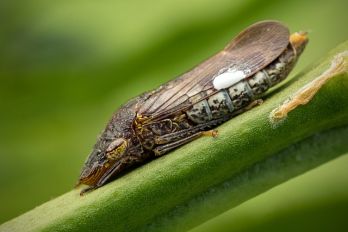Glassy-winged sharpshooter
Glassy-winged sharpshooter (Homalodisca vitripennis) is an exotic pest that has not been detected in Australia. Its wide host range presents a serious threat to our horticultural industries.
Background
Glassy-winged sharpshooter (GWSS) is found in eastern and western USA, Mexico, Tahiti, French Polynesia, and Hawaii. It has most recently spread to Easter Island and the Cook Islands.
Over 100 plant species are hosts of GWSS, including varieties of citrus, grape, olives, almond, peach and several ornamentals. All would be threatened if the pest became established in Australia.
Impacts
The insect is a xylem feeding leafhopper, targeting plant tissue that carries water from the roots to the leaves.
These feeding habits cause severe plant damage; however, the greater threat is its capacity to carry the bacterium Xylella fastidiosa. With this disease, GWSS can spread:
- Pierce’s Disease in grapevines
- olive quick decline syndrome (OQDS) in olives
- citrus variegated chlorosis disease (CVC) in citrus.
Adult GWSS are strong fliers and move rapidly between plants. Nymphs have no wings but can walk and jump through the canopy, or drop from plants to find new hosts. Most long-distance movement occurs through egg masses in nursery stock.
Management
Management
On-farm biosecurity measures will reduce the chances of pest and diseases entering properties. Take the follows measures:
- use pest-free propagation material and seedlings, sourced from a reputable supplier
- put up farm biosecurity signs on gates and fences to manage visitors coming onto the property
- avoid sharing equipment
- keep equipment and vehicles clean and free of soil and plant matter
- wear clean clothing before visiting other growers’ properties
- teach farm workers on-farm hygiene practices, what to look for and how to report unusual pests and diseases
- report suspect symptoms to the Exotic Plant Pest Hotline.
Identification
There are several sharpshooters native to Australia that have similar characteristics to the GWSS. An expert is needed to identify the insect to the species level, which is distinguished by the head shape and size.
GWSS are 12 to 14 mm long, easily seen following infestation. They are dark brown to black with yellow dots on their head and body. Their wings are clear with distinct reddish veins.
GWSS commonly sit on leaf and stem surfaces, oozing liquid that gives plants a whitewashed appearance. When carrying X. fastidiosa, they also cause leaf scorch symptoms.
Groups of up to 27 eggs are laid side-by-side on the underside of leaves beneath the surface, giving leaves a blister-like appearance. Masses of eggs are laid into growing foliage, leaving brown scars on the plants after the eggs have hatched.



